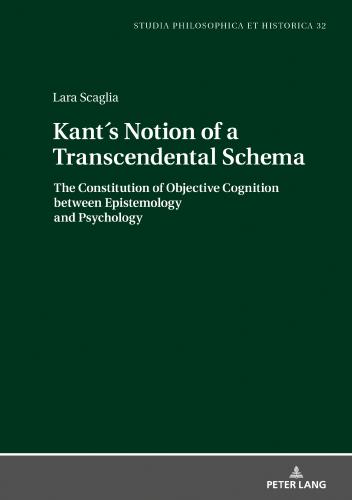Citability of the eBook
This edition of the eBook can be cited. To enable this we have marked the start and end of a page. In cases where a word straddles a page break, the marker is placed inside the word at exactly the same position as in the physical book. This means that occasionally a word might be bifurcated by this marker.
Contents
Part I: Kant’s theory of schematism and its context
1. The notion of schema before Kant
1.3.1Tetens’s conception of schema
2. Kant’s pre-critical notion of schema
2.1The metaphysical notion of schema in the Nova Dilucidatio
2.2.1Schema and the forms of the worlds
3. The introduction of the transcendental forms in the Critique of Pure Reason
3.1The doctrine of sensibility
3.2The doctrine of the understanding
4. Analysis of the schematism chapter
4.1The Transcendental Doctrine of Judgement
4.2Time-mediation
4.3Schemata and their faculty
4.4Schemata: images or concepts?
4.5The table of schemata
4.6Schemata as conditions of the significance of the pure concepts
5. Debates over the schematism chapter in Kantian scholarship
5.1Main criticisms of the schematism chapter
5.1.1A redundant addition within the Critique of Pure Reason
a)Zschocke’s focus on the Transcendental Aesthetic
b)Curtius: the schematism chapter and § 24
5.1.2Schematism’s obscure terminology
a)Curtius: difficulties concerning the notion of subsumption
b)Walsh: schemata and concepts
c)Guyer: incongruences in the relation between categories and schemata
d)Allison: difficulties concerning the distinctions among faculties and the variety of schemata’s definitions
5.1.3The priority ascribed to time over space
a)Zschocke’s criticism of time as being the only mediating function
b)Walsh’s introduction of “organic” schemata
c)Guyer: Schemata and temporality
5.2In response to the criticisms of the schematism chapter
5.2.1The necessity of schematism in the Critique of Pure Reason
a)The distinction between the function of the Transcendental Deduction and the task of the schematism chapter
b)“Knowing that and knowing how”
5.2.2The obscurity of the chapter
a)Subsumption
b)“To be” and “to do”: defining schemata
c)The distinction between categories and forms of intuition
d)Categories and schemata
e)Schemata and principles
f)Schemata and ideas
g)Judgement and its role between reason and understanding
5.2.3Space and time
